Industry News, trenchless products
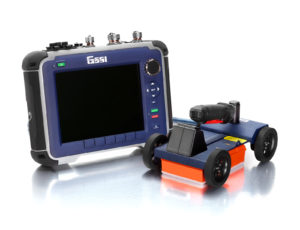 GSSI, the world’s leading manufacturer of ground penetrating radar (GPR) equipment, announces a new engineering initiative focusing on using GPR to solve difficult problems that cannot be solved with any other technologies. Led by newly appointed Vice President of Research and Development David Cist, GSSI’s expert engineering team is focusing on new products for agriculture, manufacturing, robotic inspection, industrial quality assurance/quality control, power systems preventative maintenance, and unmanned autonomous vehicle applications. GSSI’s custom solutions create completely new products, different models of existing products, or a combination of the two.
GSSI, the world’s leading manufacturer of ground penetrating radar (GPR) equipment, announces a new engineering initiative focusing on using GPR to solve difficult problems that cannot be solved with any other technologies. Led by newly appointed Vice President of Research and Development David Cist, GSSI’s expert engineering team is focusing on new products for agriculture, manufacturing, robotic inspection, industrial quality assurance/quality control, power systems preventative maintenance, and unmanned autonomous vehicle applications. GSSI’s custom solutions create completely new products, different models of existing products, or a combination of the two.
“GSSI has a long established history of developing products based on custom needs, and has commercialized several that meet broader market needs,” said Cist. “The custom solutions engineering team brainstorms with customers who are looking for novel ways of handling problems. Often enough, GPR can offer a real solution to difficult problems that can’t be solved any other way. One recent outcome is the creation of a new GPR product line with a sensor that can be integrated into a variety of robots, drones, and other equipment.”
GSSI’s PaveScan® RDM asphalt density assessment tool, which provides accurate real-time measurements to ensure pavement life and quality, was originally developed based on work commissioned by the Texas Transportation Institute (TTI) as part of the Federal Highway Administration’s Strategic Highway Research Program (SHRP2). The commercial version is now being used by state departments of transportation in Minnesota, Alaska, Maine, and Florida, as well as globally in transportation research projects conducted by universities.
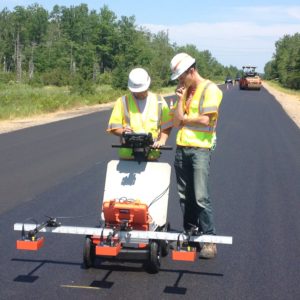 Other custom products commercialized by GSSI include the LifeLocator® TRx survivor detection system, which was originally developed in response to post-911 Homeland Security market needs. GSSI also developed one of the sensors used by the RABIT™ bridge deck assessment tool to determine bridge quality and bridge deterioration. RABIT™, developed by the Rutgers Center for Advanced Infrastructure and Transportation, is an autonomous robot that gathers quantitative data using several nondestructive evaluation technologies. The StructureScan Mini system was developed based on a specific request from one of GSSI’s largest customers in Japan, which years later was seeking a new software solution that would allow them to use the system to analyze insulated concrete forms.
Other custom products commercialized by GSSI include the LifeLocator® TRx survivor detection system, which was originally developed in response to post-911 Homeland Security market needs. GSSI also developed one of the sensors used by the RABIT™ bridge deck assessment tool to determine bridge quality and bridge deterioration. RABIT™, developed by the Rutgers Center for Advanced Infrastructure and Transportation, is an autonomous robot that gathers quantitative data using several nondestructive evaluation technologies. The StructureScan Mini system was developed based on a specific request from one of GSSI’s largest customers in Japan, which years later was seeking a new software solution that would allow them to use the system to analyze insulated concrete forms.
The GSSI custom solution applications engineering team has developed GPR systems for golf course irrigation inspection, tree root inspection, horizontal drilling, detecting the porosity of bricks, and border patrol tunnel inspection systems. Applications under development include use of GPR to establish precise soil elevation and inspection of large and expensive equipment tires used in mining.
For more information on custom solutions and products based on GSSI’s GPR technology, contact sales@geophysical.com.
About GSSI
Geophysical Survey Systems, Inc. is the world leader in the development, manufacture, and sale of ground penetrating radar (GPR) equipment, primarily for the concrete inspection, utility mapping and locating, road and bridge deck evaluation, geophysics, and archaeology markets. Our equipment is used all over the world to explore the subsurface of the earth and to inspect infrastructure systems non-destructively. GSSI created the first commercial GPR system nearly 50 years ago and continues to provide the widest range and highest quality GPR equipment available today.
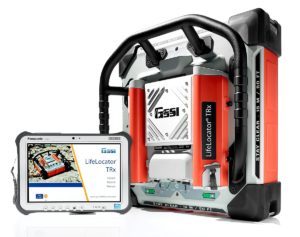
Blog, Industry News, trenchless products
XL-I Series Hole Openers Are Designed From the Ground Up For HDD
 (Hutchinson, Kansas) – StraightLine HDD recently expanded its hole opener offering with the introduction of the XL-I Series. Designed from the ground up for horizontal directional drilling, the XL-I Series is positioned as a cost-effective alternative to “split-bit” hole openers.
(Hutchinson, Kansas) – StraightLine HDD recently expanded its hole opener offering with the introduction of the XL-I Series. Designed from the ground up for horizontal directional drilling, the XL-I Series is positioned as a cost-effective alternative to “split-bit” hole openers.
At the core of the design are proprietary cones—available in six sizes, in either Tungsten Carbide or Mill Tooth configurations. Mounted to a purpose-built platform, the design facilitates load transfer to the shaft and bearing, with minimal radial load. The result is a dramatic improvement in production, service life and consistency, bore after bore.
Next, designers set out to address wear and performance characteristics by re-examining the interplay between cone diameter, height and carbide placement. Cones are sized and attached to the baseplate at an angle that protects vulnerable surfaces. Shortened cone height further improves wear resistance. Carbides placed to cut independent paths yield higher efficiency and longer service life.
Internally, the cone’s proprietary sealing and bearing system mitigates fluid intrusion, yielding a myriad of user benefits, from reduced torque and fuel consumption to extended tool life.
As a platform, the XL-I Series incorporates design characteristics that ensure the tool’s original geometry is maintained—even after rebuild. This approach yields consistent and repeatable performance.
The XL-I Series includes six sizes, from 12.75- to 24-inches with IF Box x Box shafts.
About StraightLine HDD
Since 1984, StraightLine has produced drilling solutions” to the trenchless industry. It’s full line of down-hole tools, wear parts and accessories are known for their innovative and rugged design. The portfolio now includes the full array of hard condition tools under the Armadrillco brand. In 2015, StraightLine HDD merged operations with Source: HDD, Inc., a leading provider of used HDD rigs and support equipment. Together, the merger created a company offering total HDD solutions—from rig to bit. Call 620.802.0200 or visit www.straightlinehdd.com for details.
Industry News
 Apply for ISTT’s International No-Dig Awards!
Apply for ISTT’s International No-Dig Awards!
Deadline of submission: 15th August 2017 (Extended from 31st July!)
The winner will be announced at No-Dig Colombia (25-27th September 2017)
Four categories are eligible to receive Awards as shown below. Awards may not be made in all categories in a given year.
- Academic research or training aid/course.
- Trenchless project completed.
- New machine, tool, material, system or technique introduced.
- Student or young professional paper – Members regularly enrolled in college or university, or spending at least half their time on academic course work
The aim of ISTT is to promote the science and practice of trenchless technology, and the Awards are to raise the profile and status of the Society and its Award Winners. All award winners (1) are recognized at the Gala dinner and presented a trophy and certificate, (2) are featured in an article in Trenchless International, (3) are added to the published list of ISTT award winner role of honor posted on the ISTT website, and (4) are authorized to use the ISTT logo on promotional material related to the award activity or recipients. In addition, the winner may be afforded an opportunity to make a brief presentation on the activity that received the award at the Conference time and schedule permitting. The student award winner receives a small cash award and limited financial travel assistance to attend the Conference. Visit the ISTT website for details!
Blog, Industry News, trenchless projects
Custom Robbins Machine finishes on a High Note under Low Cover
 On June 8, 2017, a select group of project officials, including Mexico’s President Enrique Peña Nieto, celebrated the final breakthrough of an epic tunneling project. The 8.7 m (28.5 ft) diameter Robbins Crossover TBM is the first such hybrid machine to operate in North America, and it completed the Túnel Emisor Poniente (TEP) II on a high note. The TBM, known an XRE—a Crossover (X) between Rock (R) and EPB (E) TBMs—navigated fault zones, variable ground, low cover, and more to achieve a national record of 57 m (187 ft) in one day as well as maximum rates of 231 m (758 ft) in one week and 702 m (2,303 ft) in one month.
On June 8, 2017, a select group of project officials, including Mexico’s President Enrique Peña Nieto, celebrated the final breakthrough of an epic tunneling project. The 8.7 m (28.5 ft) diameter Robbins Crossover TBM is the first such hybrid machine to operate in North America, and it completed the Túnel Emisor Poniente (TEP) II on a high note. The TBM, known an XRE—a Crossover (X) between Rock (R) and EPB (E) TBMs—navigated fault zones, variable ground, low cover, and more to achieve a national record of 57 m (187 ft) in one day as well as maximum rates of 231 m (758 ft) in one week and 702 m (2,303 ft) in one month.
“The XRE has a great advantage as it is designed to work in open and/or closed mode (EPB); allowing it to excavate the tunnel either in soil or in rock. We’ve verified that its performance was very efficient,” said Ing. Juan Alberto Herrera Moro y Castillo, TEP II Section Chief for owner CONAGUA, Mexico’s National Water Commission.
The unique machine and its Robbins continuous conveyor system were built on location using Onsite First Time Assembly (OFTA), and designed for a contractor consortium of Aldesem, Proacon, and Recsa. The Robbins XRE TBM featured components like a convertible cutterhead with interchangeable cutting tools, interchangeable TBM belt conveyor and screw conveyor, and multi-speed gearboxes to increase torque for tunneling through difficult ground. “The benefits of the design are in its exceptional thrust power and in the ease of changing the cutterhead torque. This makes the process much easier should the machine become stuck in difficult ground,” said Alberto Martinez, head of the tunneling department for RECSA.
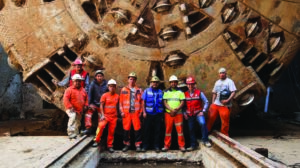 The XRE machine was launched in August 2015 to bore the 5.8 km (3.6 mi) long wastewater tunnel. The machine was set up in a hard rock configuration and mounted with 20-inch diameter disc cutters. Early in 2016 the TBM hit the first of several contact zones, a 30 m (98.4 ft) wide fault of fractured and blocky rock. While the excavation through the contact zone was slow going, progress picked up again in the more competent andesite rock. After an intermediate breakthrough in March 2016 into an 80 m (262.5 ft) deep shaft followed by inspection and maintenance, the TBM continued on.
The XRE machine was launched in August 2015 to bore the 5.8 km (3.6 mi) long wastewater tunnel. The machine was set up in a hard rock configuration and mounted with 20-inch diameter disc cutters. Early in 2016 the TBM hit the first of several contact zones, a 30 m (98.4 ft) wide fault of fractured and blocky rock. While the excavation through the contact zone was slow going, progress picked up again in the more competent andesite rock. After an intermediate breakthrough in March 2016 into an 80 m (262.5 ft) deep shaft followed by inspection and maintenance, the TBM continued on.
While boring in fractured andesite rock in autumn 2016, the TBM encountered a naturally occurring cavern believed to be the result of either a rock fall in a transition zone, or an old, underground lake body that had eroded the rock away. The cavern was estimated at 90 cubic meters (3,200 cubic ft) in size, including about 57 cubic meters (2,010 cubic ft) of unstable floor area. The TBM was stopped and immediate measures were taken to stabilize the ground in front of the machine with polyurethane foam before filling the cavern with a mixture of pea gravel and grout.
By the end of October 2016, the TBM had reached a final 900 m (2,950 ft) long section of soft ground, where it was converted to EPB mode. In this final reach of tunnel with low cover, the distance from the top of the tunnel to residential home foundations was as low as 4 m (13 ft), and the ground had the consistency of reconsolidated soil. In order to stabilize the soft soils and minimize the risk of settlement below the residential area, the tunneling crew drilled from the surface and installed 890 micro-piles at 1.0 m (3.3 ft) intervals. “We were able to do this without causing damage to property owned by neighbors in the zone bordering the path of TEP II, or to the road or the urban infrastructure installed in that area,” explained Ing. Francisco Miguel Lopez, Jobsite Manager TEP II for contractor Aldesa.
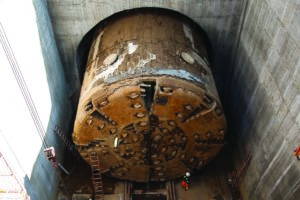 Now that tunneling is complete, the tunnel will receive a secondary concrete lining of 35 cm (14 in) thickness before going into service. The wastewater tunnel will overhaul the current system in western areas outside of Mexico City and serve to prevent recurrent flooding in Valle Dorado. In particular, the tunnel will benefit the cities of Cuautital Izcalli, Tlalnepantla, and Atizapan de Zaragoza, which altogether are home to 2.1 million inhabitants.
Now that tunneling is complete, the tunnel will receive a secondary concrete lining of 35 cm (14 in) thickness before going into service. The wastewater tunnel will overhaul the current system in western areas outside of Mexico City and serve to prevent recurrent flooding in Valle Dorado. In particular, the tunnel will benefit the cities of Cuautital Izcalli, Tlalnepantla, and Atizapan de Zaragoza, which altogether are home to 2.1 million inhabitants.
Image 1: The 8.7 m (28.5 ft) diameter Robbins XRE TBM was the first Crossover machine to bore in North America.
Image 2: Robbins personnel stand proudly in front of the Crossover TBM for Túnel Emisor Poniente (TEP) II—the project resulted in challenges as well as national records for TBM advance.
Image 3: During its bore, the Crossover achieved a national record for TBM advance, excavating 57 m (187 ft) in one day as well as achieving high rates of 231 m (758 ft) in one week and 702.2 m (2,303 ft) in one month.
Blog, Industry News
 THOMPSON, CONNECTICUT USA, July 5, 2017
THOMPSON, CONNECTICUT USA, July 5, 2017
Numa, the world’s leading drilling technology provider, is proud to announce the addition of Drilling Supplies Europe (DSE) as its new distributor in Ireland. DSE is a leading supplier and manufacturer of consumables and equipment to the ground engineering market and brings a wealth of drilling experience to support the Numa DTH hammer and bit product line.
Established in 2001, DSE was formed to cater to the new and expanding HDD sector in Ireland. The company supplied the day to day consumables such as drilling heads, dies and drilling fluids. In March of 2017, industry veteran Niall Meehan took over as owner and managing director of DSE. Niall has over 20 years of industry experience and has completed numerous projects in the fields of water well, geotechnical, environmental, geothermal, trenchless, CBM and Shale & Gas Storage. DSE brings a great depth of experience to customers along with extensive product knowledge, practical solutions and a friendly service. The company also represents many other leading brands from drilling fluids to drilling rigs, compressors and mud pumps. The combination of a wide range of products, now including Numa DTH hammers and bits, allows DSE to tailor drilling packages to the specific needs of customers in the region.
Ralph Leonard, President of Numa, commented, “We are delighted to have partnered with DSE for the distribution of Numa’s DTH products. DSE is an extremely knowledgeable company focused on service and support which is an essential component to our continued expansion in the European market.”
Niall Meehan owner of DSE added, “Numa is a highly versatile and innovative manufacturer with a big future. We’re proud to be aligned with such a top flight organization as we continue to provide the right solutions for our customers”.
ABOUT NUMA
Numa provides the world’s leading drilling technology with over 110 DTH Hammer and Bit products serving 11 different industries. Our products are designed to drill vertical, horizontal, and reverse circulation holes from 3½ to 48 inches (89 – 1219 mm) in diameter in hard rock, overburden, or loose strata formations. Having customers in 105+ countries, we have built our customer-centric reputation on providing the highest value in products, performance, and personal service available in the rock drilling industry.
ABOUT DRILLING SUPPLIES EUROPE
Established in 2001 and with over 20 years of industry experience, Drilling Supplies Europe is a leading supplier and manufacturer of equipment and materials for both the trenchless and vertical drilling sectors.
The company has the knowledge and experience to provide and support industry with quality, reliable product at affordable prices.
Blog, Industry News, trenchless people
 OLATHE, Kansas, July 10, 2017 — Vermeer Great Plains, a full-service construction equipment dealer with locations in Kansas, Oklahoma, and Western Missouri, is now 100 percent employee-owned through an employee stock ownership plan (ESOP).
OLATHE, Kansas, July 10, 2017 — Vermeer Great Plains, a full-service construction equipment dealer with locations in Kansas, Oklahoma, and Western Missouri, is now 100 percent employee-owned through an employee stock ownership plan (ESOP).
As part of the new ESOP structure, Scott Ryals, former General Manager of Vermeer Great Plains, has taken on responsibilities as Chief Executive Officer. He leads the dealership with a vision focused on maximizing and improving the customer experience, though this goal is nothing new for the dealer’s employees.
“Since Vermeer Great Plains was founded, we have placed a high emphasis on serving our customers, Ryals said.” “The new ESOP plan will only reinforce this culture as the dealership’s success will directly benefit our employees who work every day to take care of our customers. We’re all working toward the same goal.”
Research shows that an employee ownership structure creates a positive work environment as employees all work towards a common goal. In the upcoming months, the employees of Vermeer Great Plains will be further educated about the new ESOP structure.
“The transition to the ESOP means the employees will receive an added future benefit based on how well we all grow the company,” Ryals said.
Customers have always been the most important aspect of the Vermeer Great Plains vision. They can expect even better service as the company learns and grows through this transition. According
to the ESOP Association, 84 percent of companies who participate agree the ESOP improved motivation and productivity. The combination of determined employees, excellent leadership and a
fresh employee-owned plan is sure to be a recipe for success and outstanding customer satisfaction at Vermeer Great Plains.
About Vermeer Great Plains
Vermeer Great Plains is a full-service dealer of Vermeer industrial equipment across Kansas, Oklahoma, and Western Missouri. Established in 1964, the dealership has grown to five locations in the region with 80 team members dedicated to sales, parts and service. Now 100 percent employee-owned, the Vermeer Great Plains team supports customers in the treecare, landscape, wood waste, organic recycling and underground utility construction industries. Vermeer and the Vermeer logo are trademarks of Vermeer Manufacturing Company in the U.S. and/or other countries.
© 2017 Vermeer Corporation. All Rights Reserved.
Blog, Industry News, trenchless products
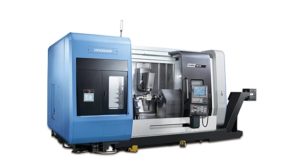 THOMPSON, CONNECTICUT USA, Jun 27, 2017:
THOMPSON, CONNECTICUT USA, Jun 27, 2017:
Numa, the world’s leading drilling technology provider, has announced an expansion of manufacturing capabilities at its US plant to keep up with growing demand for its DTH hammers and bits.
Over the past several years, Numa has heavily invested in its manufacturing capabilities to tackle the demands of building the world’s leading DTH equipment. The latest addition is a Doosan Puma 3100 which is a composite turning center that combines the functions of both a lathe and a machining center. By integrating the capabilities of multiple machines into one system, the turning center minimizes machining time and the number of machining operations. Complicated parts that previously required multiple machines and setups can now be completed by just one unit and one setup. The new equipment will improve productivity, precision, and ease of operation for the company and further improve its ability to manufacture quality products in a timely manner for its customers.
“The expansion of Numa’s manufacturing capabilities supports our vision for growth and puts us in the best position to build the world’s leading down hole hammers and bits,” said Ralph Leonard, President of Numa, “The new multi-tasking turning center offers higher productivity, greater accuracy, and enhanced user convenience which is instrumental to support the growth of our customers.”
ABOUT NUMA
Numa provides the world’s leading drilling technology with over 110 DTH Hammer and Bit products serving 11 different industries. Our products are designed to drill vertical, horizontal, and reverse circulation holes from 3½ to 48 inches (89 – 1219 mm) in diameter in hard rock, overburden, or loose strata formations. Having customers in 105+ countries, we have built our customer-centric reputation on providing the highest value in products, performance, and personal service available in the rock drilling industry.
Blog, Industry News, trenchless projects
Large Diameter XRE Machine to bore Akron, Ohio’s Wastewater Tunnel
 A Robbins Crossover (XRE) TBM measuring 9.26 m (30.4 ft) in diameter underwent factory acceptance on May 30, 2016. The gargantuan machine was initially unveiled at Robbins’ Solon, Ohio headquarters during a press day on May 25 before being shipped 40 km (25 mi) south for construction of the Ohio Canal Interceptor Tunnel (OCIT) in Akron. Those present included Akron Mayor Daniel Horrigan, Robbins chief engineer Dennis Ofiara, and David Chastka, project engineer for contractor Kenny-Obayashi JV.
A Robbins Crossover (XRE) TBM measuring 9.26 m (30.4 ft) in diameter underwent factory acceptance on May 30, 2016. The gargantuan machine was initially unveiled at Robbins’ Solon, Ohio headquarters during a press day on May 25 before being shipped 40 km (25 mi) south for construction of the Ohio Canal Interceptor Tunnel (OCIT) in Akron. Those present included Akron Mayor Daniel Horrigan, Robbins chief engineer Dennis Ofiara, and David Chastka, project engineer for contractor Kenny-Obayashi JV.
The TBM, which includes features of both EPB and Hard Rock Single Shield TBM types, is the first Crossover machine to be used in the United States. It will be launched from a 12 m (40 ft) deep portal site and build the first 68 m (226 ft) in soft ground, transitioning to a 183 m (600 ft) long zone of partial face shale before switching to hard-rock mode for the remainder of the drive in full face shale. Probe drilling will be done continuously using two probe drills to determine which mode the TBM should be in.
Unique aspects of the machine include a versatile cutterhead that will be configured with consideration for both the short soft ground section and the longer section (about 65% of the tunnel) in hard rock. A combination of disc cutters and sacrificial rippers will be used in case a cutter becomes blocked. The required rolling torque of the disc cutters has been reduced by 25% to encourage smooth rotation in soft ground. The motors of the XRE machine have been reworked from an original EPB configuration to permit higher motor speed at reduced torque for the open mode segments of the drive.
 Muck removal will be achieved with a durable screw conveyor, the first flight of which is covered welded-in wear plates. The auger shaft is lined with hard facing in a crosshatch pattern, while the screw conveyor casing has been similarly lined in wear plates and hard facing. A wear monitoring plan has been prepared for the entire drive in order to maximize efficiency in the section of more abrasive rock. Robbins Project Manager Pablo Salazar is proud of the utilization of local jobs during the TBM construction and design process: “We have built good portion of the machine in the northeast Ohio area. Many components were fabricated locally with sub-suppliers, as well as in our own shop.” The muck will be transported out of the tunnel using a Robbins continuous conveyor system—the setup will be the 100th such conveyor supplied by Robbins for operation behind a TBM.
Muck removal will be achieved with a durable screw conveyor, the first flight of which is covered welded-in wear plates. The auger shaft is lined with hard facing in a crosshatch pattern, while the screw conveyor casing has been similarly lined in wear plates and hard facing. A wear monitoring plan has been prepared for the entire drive in order to maximize efficiency in the section of more abrasive rock. Robbins Project Manager Pablo Salazar is proud of the utilization of local jobs during the TBM construction and design process: “We have built good portion of the machine in the northeast Ohio area. Many components were fabricated locally with sub-suppliers, as well as in our own shop.” The muck will be transported out of the tunnel using a Robbins continuous conveyor system—the setup will be the 100th such conveyor supplied by Robbins for operation behind a TBM.
The machine was dubbed “Rosie” in honor of Rosie the Riveter, an icon representing the American women who worked in factories and shipyards during World War II. Hundreds of “Rosies” including Akron resident Rose May Jacob worked in factories to turn out materials and armaments for the Allied war effort. The TBM will be shipped in truckloads to the jobsite, with the large cutterhead shipped in four pieces. “The entire process of assembly has allowed the contractor to follow very closely through the testing of the machine, so they are very familiar with the TBM at this point. At the jobsite, we will also provide immediate support for both spare parts and personnel,” said Salazar. Jobsite supervisors from Robbins will assist in TBM assembly and excavation for at least the first 1,000 m (3,280 ft) of boring. Tunnel boring is scheduled to begin in August of this year.
 The OCIT Project for the City of Akron consists of the construction of a conveyance and storage tunnel system to control Combined Sewer Overflows (CSOs) for several regulators in the downtown Akron area. The EPA-mandated project includes the 1.89 km (1.17 mi) conveyance and storage tunnel, as well as drop shafts, diversion structures, consolidation sewers, and related structures. The consent decree specifies that the tunnel must be operational by December 31, 2018.
The OCIT Project for the City of Akron consists of the construction of a conveyance and storage tunnel system to control Combined Sewer Overflows (CSOs) for several regulators in the downtown Akron area. The EPA-mandated project includes the 1.89 km (1.17 mi) conveyance and storage tunnel, as well as drop shafts, diversion structures, consolidation sewers, and related structures. The consent decree specifies that the tunnel must be operational by December 31, 2018.
Image 1: The 9.26 m (30.4 ft) diameter Robbins Crossover Tunnel Boring Machine (TBM) was designed and built in Robbins’ Solon, Ohio, USA facility.
Image 2: Robbins personnel proudly stand in front of the 9.26 m (30.4 ft) machine dubbed “Rosie”—the first Crossover TBM in the U.S.
Image 3: The Robbins TBM will bore in sections of both hard rock and soft ground to complete the Akron Ohio Canal Interceptor Tunnel (OCIT).
Blog, Industry News, trenchless products
 GSSI, the world’s leading manufacturer of ground penetrating radar (GPR) equipment, announces the launch of the StructureScan™ Pro, a premier concrete scanning system that can accurately inspect concrete, measure slab thickness, and locate voids. StructureScan Pro is the ideal system for locating rebar, post-tension cables, and conduits; conduct real tie surveys for core clearance or post process data for reports. It reaches depths ranging from 0-18 inches. The system includes the newly updated SIR® 4000 control unit and a choice of the popular 1600 MHz or high-resolution 2600 MHz antenna. With a basic antenna upgrade, the SIR-4000 controller can also be used for utility detection and deep void detection applications.
GSSI, the world’s leading manufacturer of ground penetrating radar (GPR) equipment, announces the launch of the StructureScan™ Pro, a premier concrete scanning system that can accurately inspect concrete, measure slab thickness, and locate voids. StructureScan Pro is the ideal system for locating rebar, post-tension cables, and conduits; conduct real tie surveys for core clearance or post process data for reports. It reaches depths ranging from 0-18 inches. The system includes the newly updated SIR® 4000 control unit and a choice of the popular 1600 MHz or high-resolution 2600 MHz antenna. With a basic antenna upgrade, the SIR-4000 controller can also be used for utility detection and deep void detection applications.
StructureScan Pro locates embedments in real-time, showing such information as focus mode, zoom data, depth calibration and target markers. It also allows users to create x-ray-like 3D images of a survey area. The intuitive data visualization features includes the ability to slice through each data layer. Additional features include multiple color themes and save image functionality.
The updated SIR 4000 controller used with the StructureScan Pro is designed to bridge the legacy of GSSI’s traditional analog antennas with next-generation of digital offerings. The updates bring the StructureScan 2D collection module to the controller, simplifying its use for the concrete construction industry. The module includes high frequency antenna-specific set-ups to ensure survey efficiency, and enables the controller to automatically recognize smart antenna set-ups.
The updated SIR 4000 also enables the option of on-the-fly automatic gain to better enhance the data display, while still saving the file in the original raw format for post processing. Fully integrated, the SIR 4000 provides a 10.4 inch high definition LED display, a simple user interface, and plug-and-play GPS integration. The SIR 4000 is designed with a number of exclusive features, including a cast aluminum chassis that offers superior temperature stability, and an impact-resistant design that is fully IP 65 rated and can withstand tough jobsite conditions.
Offering the maximum in mobility, the StructureScan Pro system includes a lightweight, rugged handcart that is simple to transport. Also included is a 7-meter control cable, a rugged carrying case, two batteries and charger.
About GSSI
Geophysical Survey Systems, Inc. is the world leader in the development, manufacture, and sale of ground penetrating radar (GPR) equipment, primarily for the concrete inspection, utility mapping and locating, road and bridge deck evaluation, geophysics, and archaeology markets. Our equipment is used all over the world to explore the subsurface of the earth and to inspect infrastructure systems non-destructively. GSSI created the first commercial GPR system nearly 45 years ago and continues to provide the widest range and highest quality GPR equipment available today.
Blog, Industry News, trenchless products
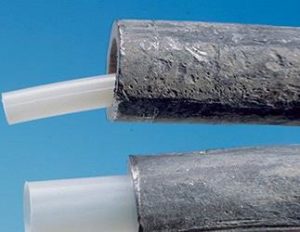 Ottawa, IL, June 20, 2017 – LMK Technologies is proud to announce its continued five year partnership with Flow-Liner as a National Distributor of the Neofit System. The updated Neofit system is a durable, green, and cost effective method of trenchless rehabilitation of potable water lines, providing almost instantaneous results with increased flow rate and minimal diameter loss while creating a barrier from lead, preventing contamination and making water safe for consumers.
Ottawa, IL, June 20, 2017 – LMK Technologies is proud to announce its continued five year partnership with Flow-Liner as a National Distributor of the Neofit System. The updated Neofit system is a durable, green, and cost effective method of trenchless rehabilitation of potable water lines, providing almost instantaneous results with increased flow rate and minimal diameter loss while creating a barrier from lead, preventing contamination and making water safe for consumers.
“LMK is very excited to continue partnership with Flow-Liner,” says Larry Kiest, Jr., President, CTO and Founder of LMK Technologies. “We look forward to promoting this technology with our highly skilled network of licensed contractors and distributors so water utilities across the country can benefit from improved water quality and meet the demand for renewed water service lines, complimenting the rise in rehabilitation of water mains.”
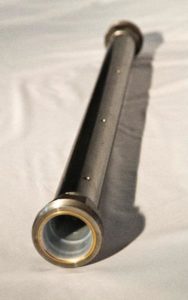 Neofit+ Plus System is a non-invasive pipe lining system especially designed for small diameter potable water service piping. The Neofit+ Plus Liner seals small leaks and pinholes in 1/2″ thru 2″ ID service piping. It also acts as a barrier between existing lead piping and potable drinking water. The Neofit+ Plus Liner is NSF-61 approved and has been tested to a minimum 50+ year life expectancy. LMK is promoting the advanced Neofit processing equipment, now providing lining lengths up to 300 feet. The technique necessitates minimal disturbance of surrounding ground, removing the risk of damaging other utility services. The absence of chemicals required makes it environmentally friendly and allows consumers to receive immediate return to service post processing.
Neofit+ Plus System is a non-invasive pipe lining system especially designed for small diameter potable water service piping. The Neofit+ Plus Liner seals small leaks and pinholes in 1/2″ thru 2″ ID service piping. It also acts as a barrier between existing lead piping and potable drinking water. The Neofit+ Plus Liner is NSF-61 approved and has been tested to a minimum 50+ year life expectancy. LMK is promoting the advanced Neofit processing equipment, now providing lining lengths up to 300 feet. The technique necessitates minimal disturbance of surrounding ground, removing the risk of damaging other utility services. The absence of chemicals required makes it environmentally friendly and allows consumers to receive immediate return to service post processing.
To learn more about the Neofit+ Plus System, please contact LMK at 815-640-9302.
LMK Technologies, a world leader specializing in trenchless methods to renew subterranean pipeline infrastructure, has more than one hundred U.S. and foreign issued patents for its advancements in trenchless technology. Headquartered in Ottawa, IL since 1993, LMK serves the municipal, commercial and residential markets through a network of licensed and certified contractors. For more information regarding LMK, please visit www.lmktechnologies.com, call 1-815-640-9302 or email info@lmktechnologies.com.
 GSSI, the world’s leading manufacturer of ground penetrating radar (GPR) equipment, announces a new engineering initiative focusing on using GPR to solve difficult problems that cannot be solved with any other technologies. Led by newly appointed Vice President of Research and Development David Cist, GSSI’s expert engineering team is focusing on new products for agriculture, manufacturing, robotic inspection, industrial quality assurance/quality control, power systems preventative maintenance, and unmanned autonomous vehicle applications. GSSI’s custom solutions create completely new products, different models of existing products, or a combination of the two.
GSSI, the world’s leading manufacturer of ground penetrating radar (GPR) equipment, announces a new engineering initiative focusing on using GPR to solve difficult problems that cannot be solved with any other technologies. Led by newly appointed Vice President of Research and Development David Cist, GSSI’s expert engineering team is focusing on new products for agriculture, manufacturing, robotic inspection, industrial quality assurance/quality control, power systems preventative maintenance, and unmanned autonomous vehicle applications. GSSI’s custom solutions create completely new products, different models of existing products, or a combination of the two. Other custom products commercialized by GSSI include the LifeLocator® TRx survivor detection system, which was originally developed in response to post-911 Homeland Security market needs. GSSI also developed one of the sensors used by the RABIT™ bridge deck assessment tool to determine bridge quality and bridge deterioration. RABIT™, developed by the Rutgers Center for Advanced Infrastructure and Transportation, is an autonomous robot that gathers quantitative data using several nondestructive evaluation technologies. The StructureScan Mini system was developed based on a specific request from one of GSSI’s largest customers in Japan, which years later was seeking a new software solution that would allow them to use the system to analyze insulated concrete forms.
Other custom products commercialized by GSSI include the LifeLocator® TRx survivor detection system, which was originally developed in response to post-911 Homeland Security market needs. GSSI also developed one of the sensors used by the RABIT™ bridge deck assessment tool to determine bridge quality and bridge deterioration. RABIT™, developed by the Rutgers Center for Advanced Infrastructure and Transportation, is an autonomous robot that gathers quantitative data using several nondestructive evaluation technologies. The StructureScan Mini system was developed based on a specific request from one of GSSI’s largest customers in Japan, which years later was seeking a new software solution that would allow them to use the system to analyze insulated concrete forms.















